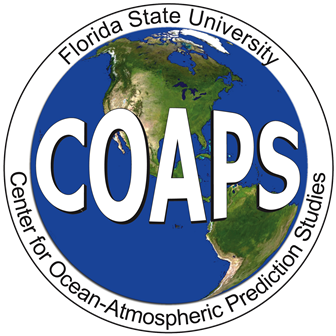NOTICE: AS OF Feb-2020 THIS PRODUCT IS NO LONGER BEING UPDATED.
Some ENSO impact analyses, particularly those in COAPS, categorize application data as belonging to one of three phases of ENSO: El Niño (warm SST anomalies in the Pacific) El Viejo (cool SST anomalies), or neutral based on an index derived from observed SST anomalies. The particular index chosen is that from the Japan Meteorological Agency (JMA) because it selects well the known ENSO events. The index is a 5-month running mean of spatially averaged SST anomalies over the tropical Pacific: 4°S-4°N, 150°W-90°W. If index values are 0.5°C or greater for 6 consecutive months (including OND), the ENSO year of October through the following September is categorized as El Niño, El Viejo (index values equal or exceed -0.5°C), or neutral (all other values). A plot of these data show their relative values since 1970.
For the period 1949 to 2020, the JMA-Index is based on observed data. However, for the years 1868-1948 the index is based on reconstructed monthly mean SST fields. The reconstructed SST fields were computed using an orthogonal projection technique (Meyers et al., 1997). The JMA index for 1868-1949 was calculated just as for the 1949-2020, meaning the JMA climatological values were used to calculate the JMA SST anomalies. A 5-month running mean was then applied resulting in the JMA index.The JMA Index values for each month of the 1868-1949 period are available here. (https://data.coaps.fsu.edu/pub/JMA_SST_Index/).
Correction - (17 July 2003): The ENSO years of 1870 and 1974 were reclassified from neutral to cold phases. The original classification of these years was the result of inconsistent application of the -0.5C threshold for cold phases. In these two cases, several 5-month running mean values in the six month period that included OND were equal to -0.5C, but the years were incorrectly classified as neutral. This correction only affects the list in Table 1, not any files available from our data site.
Table 1: The years in each category correspond to the first three months of the ENSO year namely October, November, and December. For example, the ENSO year 1970 starts October 1970 and ends September 1971.
| Cold Phase | Neutral Phase | Warm Phase |
|---|---|---|
| 1869 1870 1871 1872 1873 1874 1875 1886 1889 1892 1893 1903 1906 1908 1909 1910 1916 1922 1924 1938 1942 1944 1949 1954 1955 1956 1964 1967 1970 1971 1973 1974 1975 1988 1998 1999 2007 2010 |
1876 1878 1879 1881-1885 1887 1890 1891 1894 1895 1897 1898 1900 1901 1907 1912 1914 1915 1917 1919 1920 1921 1923 1926 1927 1928 1931-1937 1939 1941 1943 1945-1948 1950 1952 1953 1958-1962 1966 1968 1977-1981 1983 1984 1985 1989 1990 1992-1996 2000 2001 2003-2005 2008 2011 2012 2013 |
1868 1877 1880 1888 1896 1899 1902 1904 1905 1911 1913 1918 1925 1929 1930 1940 1951 1957 1963 1965 1969 1972 1976 1982 1986 1987 1991 1997 2002 2006 2009 2014 2015 |
Special thanks to David M. Legler for starting this index.
To cite this index, please reference Bove, M. C., J. B. Elsner, C. W. Landsea, X. Niu, and J. J. O’Brien, 1998: Effect of El Niño on U.S. landfalling hurricanes, revisited. Bull. Amer. Meteor. Soc., 79, 2477–2482.

